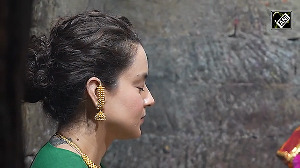Walk down any street in India and you are almost guaranteed to pass at least one middle-aged man with a glorious head of pumpkin orange hair.
The use of henna, or mehendi, as the hair dye is known locally, may be waning as western tastes sweep through the malls and markets of urban India, but it is far from dead in towns and villages.
Outside the Jama Masjid, the main mosque of old Delhi, Halim Shah, a 65-year-old from Ghaziabad, a suburb of the capital, says he has been dying his beard a flame colour with henna for the past six years. "It is a beautiful colour," he says, peering down at his near-fluorescent facial hair.
The henna hairdos represent a challenge for the likes of L'Oréal, Wella and Schwarzkopf, western companies that have entered the upper end of the $750m Indian haircare market, and to Indian houses such as Godrej and the Emami Group, which make cheaper powder or oil-based dyes.
"The men with the incredible bright orange hair do not want to go grey but they are also not ready or able to spend on the expensive colours that the big companies produce," says Seema Malhotra, proprietor of Eve's Beauty Parlour and Academy, a salon based in the Lajpat Nagar district of New Delhi.
The male grooming market in India is one of the hottest segments of the global consumer goods universe. Indian men, according to research by Gillette, one of the prime beneficiaries of the trend, spend an average of 20 minutes in the mirror each morning, longer than the 18 minutes spent by Indian women.
The segment's spectacular growth is creating a new front in the generational clash between middle-aged fathers and their increasingly westernised offspring.
"I think the orange look is hideous," says Bobby Mehta, 26, who works for a US management consultancy. "It's a crazy look, totally deranged. I would much rather they left it grey."
Rana Dasgupta, a Delhi-based author in his mid-30s, believes his generation is unlikely to follow the centuries-old tradition. "It's a folk remedy kind of thing which predates the growing self-consciousness about appearance that is prevalent in contemporary urban India. My suspicion is that this will not continue."
Young Indian women are even more adamant that the orange look has to go. "Nobody can understand why they do it," says Anita Jain, a former journalist in her mid-30s who is writing a book about love and marriage in modern India. "There's no fathomable reason for it. I suspect they have no idea what a turn-off it is."
"Hair is not what it used to be," says Patricia Oberoi of the Centre for the Study of Developing Societies. "Traditionally men and women would disguise grey with henna until they were 60, or until they had grandchildren, and then allow themselves to age. Today, with all the gelling, spiking and streaking, everything is fashion-driven."
Emami Group has recently launched a male hair dye Mr Black that specifically targets men who henna their hair. The product is competitively priced at Rs22 ($0.56, 0.39, £0.27) for a 50ml bottle, which works out at about Rs2-Rs3 per application, little more than the cost of a sachet of henna powder.
"It is for the Cs and the Ds," says Priti Surekha, director of haircare at the Kolkata-based group, referring respectively to middle and lower socioeconomic categories in which the chief wage earners tend to be employed at a clerical level, as traders and unskilled workers. "It's a beauty wake-up call for these guys."
Henna has been the dominant haircare product for centuries on the subcontinent and is used commonly, though far from exclusively, in Muslim communities. A natural red-orange pigment from the dried leaf and stem of the plant Lawsonia inermis, it is applied to the hair in the form of a paste that smells of damp clay.
"Our understanding of Indian maleness is in a state of flux," says Tamar Kasriel, founder of Futureal, a trends consultancy. "But the Indian-ness of henna means it has the appeal of being home-grown, tried and tested for centuries. This is potentially a powerful marketing platform for the future India going 'back to its roots'."
She says a strong men's henna brand could position itself in opposition to all the multinational products flooding India's haircare market. "I could imagine a resurgent confidence in what it means to be Indian and in Indian traditions lending momentum to the 'rediscovery' and growth of the henna market."
Copyright The Financial Times Limited 2007.






 © 2025
© 2025